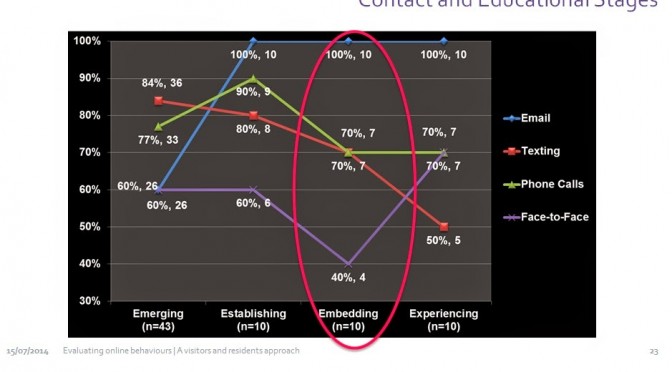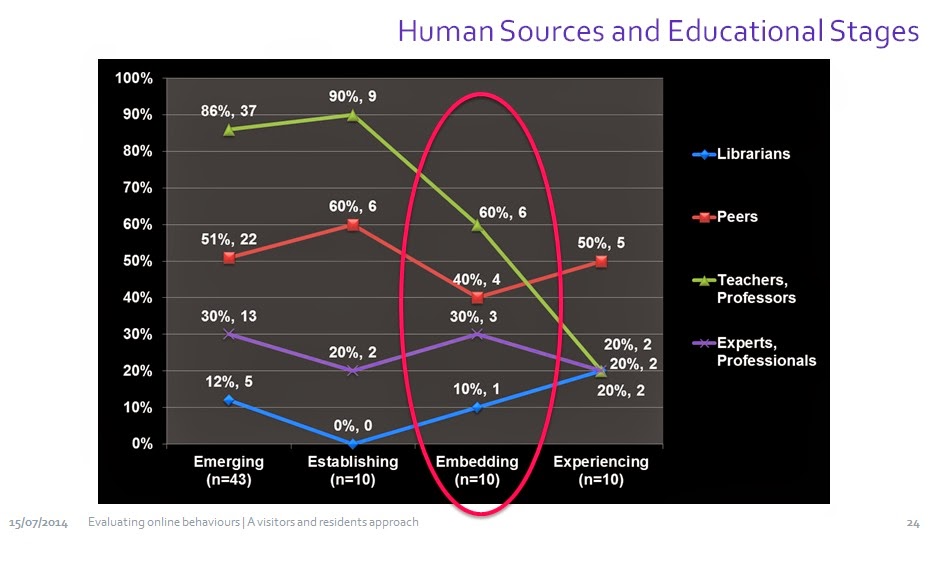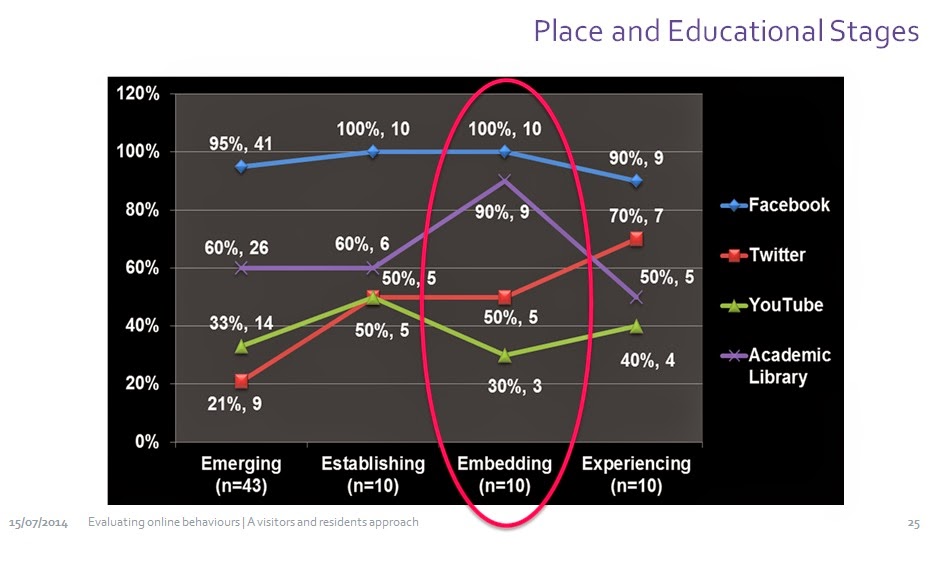So the Visitors and Residents research team (myself, Dave White, and Lynn S. Connaway) conducted a Jisc/OCLC webinar (with the generous and effective chairing of Lorcan Dempsey) yesterday. The purpose was to introduce people to our InfoKit, and also to have a chance to talk a bit more about research results and practical implications for transforming HE (and other) approaches to digital tools and places.
In my part of the webinar I focused on graduate students, and the story that I think is emerging from our data about the potential impact that digital places and communities can have on the relative isolation of graduate students from their peers. I’m reproducing part of what I said here, and a link to the webinar and full powerpoint are available here. (scroll to the bottom, thanks to the capable skills of our colleagues at Netskills for making this available). I Storified the session here. The GoogleDoc with links to project outputs, etc. is here.
I started off talking about sources and authority, actually, going over some of the findings that we cover in the People Trust People , Convenient Doesn’t Always Mean Simple, and Assessing Non-Traditional Sources part of the InfoKit. These pieces are important background to thinking about the experience of graduate students, because they are at a moment of transition, from being those who are expected to learn about authoritative sources and use them effectively, to those who are expected to become and produce authoritative sources of information themselves, as practitioners in their fields.
This transition used to take place almost entirely in physical places, in seminar rooms, laboratories, academic libraries, and at face-to-face conferences. But the Internet is a now a place where things happen, things that used to only happen face to face. A holistic picture of academic behavior, of information seeking behavior, therefore has to include these digital places, and should pay attention to resident practices as we define them in the Visitors and Residents project.

Webinars, Graduate Students, Visitors and Residents
People use social media tools and spaces like Twitter and Facebook to connect. This is not a surprising or new thing, but needs to be kept in mind, as it’s a phenomenon that is certainly not going away. We also need to collectively keep in mind that just because these digital places exist, not everyone is excited by Twitter or Facebook or Instagram. Awareness of these social media environments and the communities within them is not dependent on a generational identity, but is about personal preferences and individual motivations to engage. We cannot, should not assume monolithic attitudes towards these places and tools. Digital places like YouTube and Facebook and Twitter are not easily classed as only “entertainment” or “academic” in character or purpose, because of the wide range of activities that now occur in those spaces. Knowing that someone goes to YouTube doesn’t tell you why they are there, or what they might do, or who they might seek out there.
So these graphs are interesting to me, because they seem to point to an opportunity to help graduate students.
I’ve put a red oval around the post-graduate/ grad student category, that we call Embedding.
Notice here the purple line for face to face contact, and notice in particular how low (comparatively) the mentions of face to face contact are for grad students. They are texting with people, making phone calls, and in particular emailing far more than engaging face to face.
Notice here who graduate students are in most contact with-professors,then peers. For Professors, it’s the reverse order—they are in touch with peers and then with experts, mentors, and librarians at similarly low rates. Think about future of graduate students, of them as future (and current) practitioners in their fields. Contact with professors makes sense, of course, but contact with peers seems crucial. How else are they going to build their community, find their voice, engage in the back and forth of scholarly communication with their fellow practitioners?
The Blue line is FB, red is Twitter, purple line is Academic Libraries (physical spaces). Graduate students narrow contact that they have with people, and are also physically isolated, working in the library, offices or labs. I see this in the other ethnographic work that I do as well, the maps that graduate students, particularly in the sciences, produce of their learning landscapes are restricted to one or two places, in sharp contrast to the wide-ranging maps of undergraduates and professors.
But when we look at the places they do go, in addition to being present in academic libraries’ physical spaces (we see a radical difference in the role of academic library spaces in our interviews with graduate students, compared to other educational stages), graduate students are present in significant rates on Facebook, and Twitter.
We need to think about implications of online resident practices for grad students. Their social media presence might be an opportunity for them to facilitate contact in the isolating environment of graduate school . This is something we need to look at further—what is happening as they transition from student to practitioner in their field? How are their experiences in physical spaces like libraries related to the academic work they do in digital places like Twitter, Facebook, and YouTube, etc.? Where are they resident, where are they visitors? If resident practices are those that facilitate the finding of voice, and the production of scholarship (in a variety of modes), what can it look like in grad school?
Watch the whole webinar:


